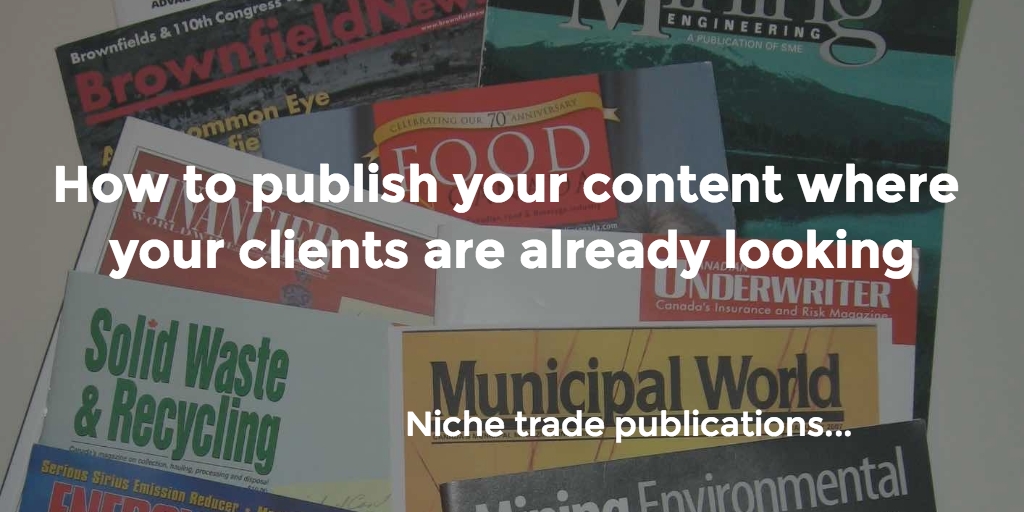To understand why, consider a lesson from a consulting gig I did in the DR Congo, in East Africa, recently. Our hotel was right on the shore of Lake Kivu, one of the Great Lakes of Africa. Each morning, from the rooftop dining room, I’d see fishing canoes out on the lake. I noticed that the crews went to very specific places along the shore to drop their nets. They knew where the fish would be, so that’s where they went.
These weren’t recreational fishermen, just doing it for fun or relaxation. This was their livelihood. How much fish they caught was a main factor in whether their children would have enough to eat the next day.
I think it’s equally important for business professionals to be careful about where they place their content. Fish where the fish are.
Why do trade magazines matter in an age of Google?
Much of current wisdom in content marketing is that if you put your content online, armed with the right keywords, your prospective clients will find it. Actually, unless you’re in a narrow niche that offers amazingly targeted keywords, that’s not going to happen. That’s because a small firm or independent professional simply can’t match the search engine credibility of a large competitor. That’s particularly true now, given the ways deep-pocketed firms can pay for sponsored posts, ads and other ways to boost the visibility of their content.What can you do to compete? Go to your ground game. It’s a game at which independent professionals, who know their clients’ needs and interests, can out-compete the global giants like KPMG, BCG and E&Y.
Do so by getting your content published in media that your prospective clients already know, like and trust. It’s their niche online and print publications, which can include:
• Trade and professional magazines – one of the few categories of print publications that is still thriving
• Websites of those publications, which often take content that won’t fit onto their printed pages
• Niche newsletters
• Association websites – groups made up of members of an industry, profession/occupation, or a cause
• High-profile, highly regarded blogs, as well as audio podcasts
Some of these are remarkably narrow in focus. How about some of the publications where I’ve helped my clients publish content recently:
• Government Fleet
• Windpower Engineering & Development
• Pipeline & Gas Journal
• LNG Industry (that’s “Liquefied Natural Gas”)
• Pit & Quarry
• Financier Worldwide
If you’re not in these industries, you’ve likely never heard of the publications. But if you are, and at a senior level, you almost certainly read every issue. I mean, who would be reading something called “Windpower Engineering & Development?” Someone who is strongly interested in renewable energy, with significant budgetary discretion.
Advertisers in these kind of publications seem to agree. There are some very smart companies paying serious money to get their message in front of these niche publications’ readers. Their published ratecards indicate single-page tariffs of US$5,000 to $10,000 or more. That’s for a publication with maybe 35,000 readers – but remember the budgetary power that those 35,000 readers control.
If you don't happen to have $10K to drop on a single-page ad (you’ll need more than one insertion, but that’s okay – there are discounts for multiple insertions!), let’s take a closer look at that ground game. You can get your content published in these magazines at no cost at all, and in a way that’s probably better than those pricey-but-worth-it ads.
A clear idea of your market helps focus your content
In another post, I’ve gone into the issue of “avatars” or “personas” – a mental construct of your ideal client. Having a good idea of your client and his/her issues and concerns helps sharpen your content on the issues that will drive them to take action. This also helps increase the chances that your content will be accepted by the publication.You can get the editor’s interest best, if you focus your content on a pressing issue that her or his readers are facing, in what we call “newsjacking” – wrapping your content around a news item affecting the readers/prospects.
Newsjacking, as well as other types of content such as the how-to and trendspotting, are covered in my e-book “Five planks to build your platform, available at no cost here.
In another post, I’ve delved more deeply into the question of how your content strategy can help you shift into new markets, by developing content in the publications read by people in the new market.
In future content, I’ll dig into how you present your idea to an editor, through a query letter. It’s a topic I’ve covered to some extent in the two books available on the Thought Leadership Resources website. For now, start to get to know the online and print media being relied upon by your potential clients, and start to think of ideas for articles that would interest them.


